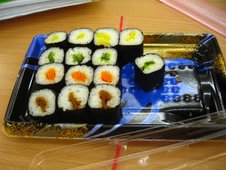Vegan Protein in Japan
How To Be A Healthy Vegan In Japan:
Protein たんぱく質
For the spoiled vegan used to meat analogs and vegan TV dinners, how do we still get all the nutrients we need with a whole food, from scratch diet? Here are a few suggestions on how to meet your daily intake goals with quick, easy, and available foods.
*Note: totals listed in the charts below may vary depending on brands, etc. Check labels to make sure how much you’re getting.*
The usual Daily Recommended Intake of protein is 0.8 g per kilo of body weight. http://www.vrg.org/nutrition/protein.htm states that some allowances may need to be made for the differences in absorption between plant and animal proteins. To be on the safe side, vegans should consume somewhere between 0.8 and 1 gram of protein per kilogram of body weight per day.
Of course the most obvious and economical sources of protein in Japan come from soy, in its many forms. In addition to regular, run of the mill tofu, other soy products include:
Abura age (あぶらあげdeep fried tofu pockets)
Agedoufu (揚げ豆腐deep fried blocks of tofu)
Koyadoufu (高野豆腐freeze dried tofu blocks about 100 yen/5 pack)
Okara (おから the pulped skins of the soy beans left over when making tofu, VERY cheap, throw a handful into whatever you’re making, also good for baking)
Yuba (湯葉 the hardened skin that forms on top when making soy milk, very delicate and not so cheap but can be tasty)
and the infamous
Natto (納豆smelly, sticky fermented soy beans that are hated by the majority of foreigners and the wise people of Osaka-fu).
The most widely used and cheapest seeds are sesame seeds (ごま). Adding a handful to whatever you’re cooking is a great way to increase your protein intake. Make sure you grind them slightly or chew them well to release their nutrients.
There are also some specialized products you can find at health food stores here, though not nearly as many as at home. Most health food stores sell dried unflavoured textured vegetable protein (TVP), tempeh, and gluten “meats” (seitan). Red and green lentils and some less common (in Japan) beans (like chickpeas) are also available at about four times what you’d pay back home.
Nuts are ridiculously expensive in Japan. Almonds are great sources of protein and calcium but cost about 300 yen for 100g. Cashews and pistachios are similarly expensive. Walnuts (くるみ)are very common and, of course, peanuts are cheapest and most widely available. Foreign stores, like Costco or ethnic import stores, are the only option for affordable nuts.
Beans are usually quite expensive in Japan. Canned beans and a few varieties of dried beans (soy) are available at Supermarkets. Legumes such as red and green lentils are also available but cost a lot. A large percentage of Japanese immigrants come from South America, especially Brazil and Peru. Depending on the area in which you live, there may be import or ethnic food stores that are an excellent, cheap sources of dried lentils and beans. If these stores aren’t available where you live, check out a Costco near you.
My favourite way to get protein is with a few traditional bean sweets. Adzuki beans (mashed into sweet red bean paste or anko) feature heavily in this category of Japanese desserts. While the mochi variety are usually vegan, always check for eggs and milk kanji. The wafer-looking shapes (usually patterened circles or fish) filled with anko are also delicious and usually vegan.
In the bean sweets category I have to digress a moment to include a recommendation of my absolute favourites. Those are kurodama (black sugar and edamame balls, available only in Kofu, Yamanashi), yomogi mochi or kusa mochi (green, made from a grassy weed that is very healthy), and ichigo daifuku (mochi filled with anko with one ripe strawberry in the middle, available only in strawberry season).
Whole grains like buckwheat noodles (soba), oats (available at health food stores and Costco), and quinoa (health food stores) also contain significant levels of protein.
Totals in the chart below are mostly taken from products I use personally; nutritional information will vary according to brand. The beans’ totals are from the brand available at Costco. Inari age is abura age that has been seasoned with soy sauce and sugar, ready for making inari sushi pockets. Nutritional information on inari age varies widely! The brand listed here is the cheapest available in my city…
Protein/100g
Freeze-dried tofu 51.8
Lentils 28.0
Peanuts 26.2
sesame seeds 22.5
Almonds 21.3
Pistachios 21.2
Tempeh 18.8
Saniku gluten meat 17.5
Saniku gluten burger 16.9
Oats 16.8
Soba 15.8
Cashews 15.3
Walnuts 15.2
Soybeans 14.7
Edamame 13.0
inari age 12.5
Miso 11.8
Mixed beans 9.2
kidney beans 10.7
Chickpeas 8.2
Tofu 6.6
inari age 12.5
agedoufu
yuba
Okara 4.8
natto
Anko 13
Anko no kimo 10



